Khajuraho, Varanasi, Bodgaya, Kolkata to Bangladesh Fri 9 – Wed 21 April 2010
We set off from Agra early on to miss some of the worst heat and traffic and arrived in Khajuraho by early afternoon. Khajuraho is put on the tourist map by its temples and particularly the temple art which is amongst the finest in the world. It felt a pleasant little town - more a rural village originally with a lot of the growth fuelled by the tourists. With tourists come the usual trappings - kids selling tourist bits and pieces, rickshaw guys touting for business and sadly quite a few beggars. We found a camp spot outside a small guest house - the Yogi Sharma Ashram Lodge - which was very nice set in shady fruit trees. It was still very intensely hot though - which maybe accounted for the fact we didn't see many other tourists.
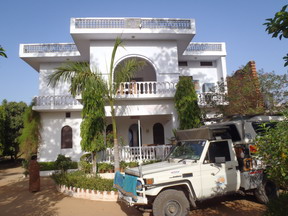

Next morning after a bit of a sticky night's sleep we headed off to see the famous of temples. There are 3 main groups the western, eastern and southern the western being the only ones you have to pay an entrance fee for (250 rupees) and the one with the most impressive temples.
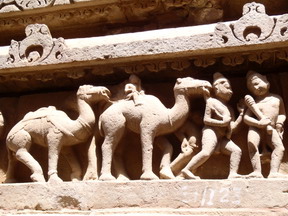

Dating from 950-1050 AD the temples were built by the powerful Chandela Dynasty. No one is sure quite why such a huge burst of incredible creativity happened here in a fairly innocuous location. Of the original 85 temples only 25 remain, the rest being destroyed by Muslim invaders from Afghanistan. The Chandelas eventually left Khajuraho which was gradually taken over by the jungle and so remained forgotten for many years. In 1838 an old British soldier T S Burt stumbled across the ruins and "re-discovered" them. In great British understatement he described them as "a little warmer than there was any absolute necessity for."

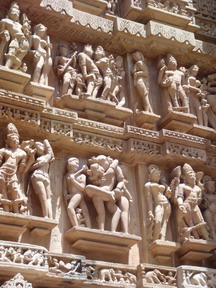
The carvings are incredible, very lifelike and in parts very very warm indeed!! They depict various aspects of everyday life that of soldiers, musicians famers but with a recurring sexual theme including lots of orgy scenes hence the soldier's comment.
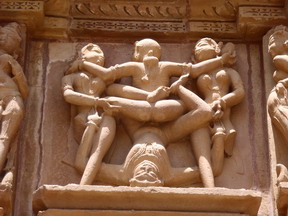
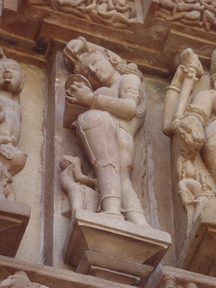
This is what the temples have (understandably!) become famous for - but both the "warm" carvings and the not so warm exhibited an incredible display of craftsmanship. We invested in an audio guide - not one of the usual Aussie narrowcasters ones but a local one which wasn't great quality though it only cost 50 rp.
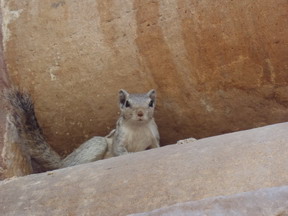
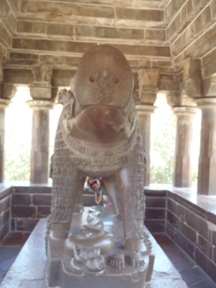
The Varaha - dedicated to the boar incarnation of the god Vishnu was amazing - a huge carving in sandstone covered in smaller carvings of a multitude of gods. It was a lovely complex just to wander around -as ever lots of squirrels playing around the monuments.
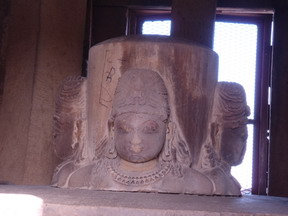

We later took a drive to the eastern group- very near a local village - where we took in the granite Brahma Temple - overlooking the Narora Sagar or River. We were a bit confused by the title as we thought we'd seen the only Brahma temple in India in Pushkar but we met a local who set us straight. It was actually incorrectly seen as a Brahma temple and the name has stuck though it was later found to be originally a temple dedicated to Vishnu. This is the oldest temple in Khajuraho.
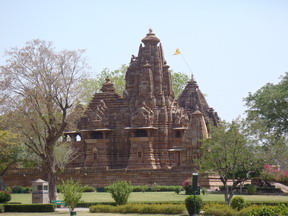
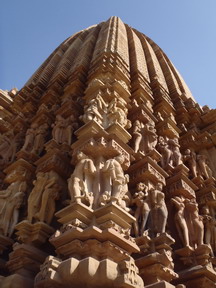
We also took in a few Jain temples the largest being Parsvanath. There are 2 sects of Jains the Svetembara and the Digambara or sky clad. The sky clad are the most severe sect and they go naked save for a peacock fan. There were quite a few sky clad monks in the temple that day - one if whom I nearly trod on where he was sitting quietly in a dark corner of the temple - all in all a day of nudity! On a serious note whilst very "warm" indeed and no doubt very upsetting to Victorian sensibilities the carvings were truly incredible. Well worth making a detour to see.
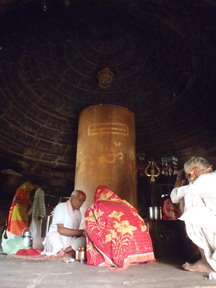
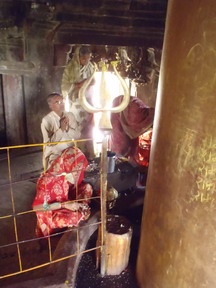
Finally we had a quick look at the remaining working temple of the area still in everyday use - the Shiva temple Matangesvara. This temple was just outside the western temples' enclosure and all morning we'd seen/heard devotees coming here ringing the bells at the entrance and going in to pray so we were a bit curious. It is a fairly plainly constructed temple with a huge (2.5 metre) polished Shiva lingam or phallic symbol in the middle. The temple was packed with devotees praying - it was interesting to see the temple in use and made it easier to imagine the whole place in its heyday with every temple swarming with life.


We took in a show of folk dancing that night organized by the Uttar Pradesh tourism department - fairly touristic but we like to support these things. Andrew very much enjoyed it particularly the marshal arts section -I thought it was a bit passé -maybe I've seen too many! To see more of the cultural programs on offer see the UP tourism site at http://www.up-tourism.com
In fact all in all a great day - only spoilt by the fact we found ourselves locked out that night! It was only 10.30pm and we'd been on the internet - but when we got back the large gate was locked. We rang and rang and finally gave up. Luckily we carry our bed around with us but less fortunately we'd left our shower tent and shower head inside so we couldn't have a shower -no fun in the heat!
The night watchmen got a telling off -he'd just locked up and gone to bed at 10pm !- and we saved on a night's parking fees but we didn't have the best night's sleep and so were a bit bleary eyed next morning when we headed on to our next destination of Varanasi.

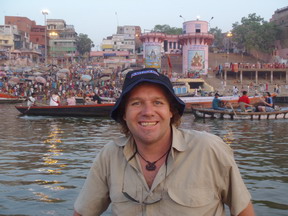
We arrived in Varanasi by mid afternoon giving us plenty of time to find a parking spot. We were really lucky as we already had a good lead - Nessie's travels - the unknown overlander's notes we've mentioned before which were given us by Kari and Walter we met in Nepal -and the Lonely Planet both mentioned the Surya Hotel as being a place that took in overlanders. Lucky we knew this - it was a bit out of town and you wouldn't want to drive the car in to the frenetic chaos of the Ghats bathing area.
Surya Hotel was very pleasing at first sight and it just kept getting better. The gracious building it was in still belongs to the Royal Family of Nepal - indeed a separate building is kept as an apartment for them when they're 'in town." It was a midrange hotel - complete with swimming pool and dressed up doorman- at fairly budget prices. The staff were used to overlanders - all the big buses from Europe stop here - and really went out of their way to be accommodating. The restaurant was also pretty good. The only downer was that we couldn't use the pool (well we could at a cost of 200 rupees extra each -which was what we were paying to park- not too bad but we gave it a miss) and the parking area was HOT HOT HOT!!! We camped in the back area near the area where off duty staff sat and it was all concrete and boy did the heat build up. It was bearable first thing in the morning and last thing at night - not in the middle! Great place to stay though and pretty affordable have a look at their site www.hotelsuryavns.com

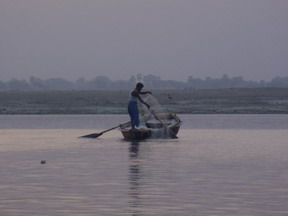
As we were pretty short on time we booked a tour to see the bathing Ghats leaving at 5am the next morning. We were pretty tired when the alarm went off as, as mentioned we'd had a disturbed night the night before followed by a big day's driving so we were a bit groggy. However we soon woke up when we hit the Ghats as there was already so much happening.
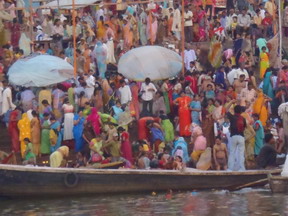
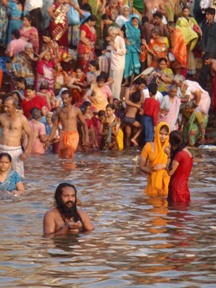
Varanasi is the most sacred place for all Hindus - the place where pilgrims come to wash away their sins and cremate their loved ones in the sacred river Ganges. Named after the 2 rivers which meet here the Varuna and the Asi Varanasi has long been a centre of religious rites and learning and claims to be one of the oldest cities in the world. To die here is hugely auspicious for Hindus as it offers moksha - liberation from the cycle of rebirth and death and a passage to heaven.
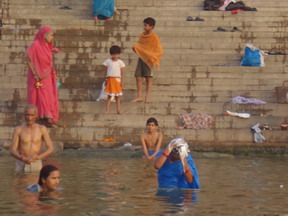
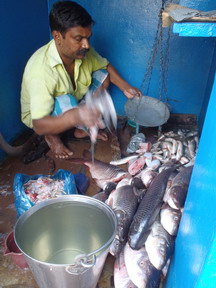
Whilst predominantly a Hindu place Buddhists and Muslims also come to bath in the Ghats and other outsiders such as us also come in droves to have a close look at these ancient religious practices still being followed. We arrived at the river before the sun rose to find a frenzy of activity. There were 5 of us on our tour and we were shown into one of the small row boats which ply their trade up and down the Ganges. The river has over 80 Ghats but much activity centres on a few of the major ones such as Dashashwamedh Ghat where we started taking a trip up the river. You pass scores of people performing puja (a religious blessing - literally the term means "respect") bathing in the water, dhobi men doing laundry, fishermen fishing from small boats and people cleaning their teeth and hair whilst further up cremations take place at the burning Ghats - though obviously you couldn't take pictures of this.
Nowadays bodies are also cremated in an oven and the ashes given to the relatives to scatter which is cheaper than being "personally" burnt on piles of wood. Some classes of people can't be burned -young children and holy men (they are deemed innocent and so don't need to be purified by fire) pregnant women, those bitten by cobras (the god Shiva's protector) and those who died due to small pox - who have already gone to the goddess of smallpox Sitala whose statue is at Dashashwamedh Ghat. These bodies which can't be burnt are weighted down with stones and sunk in the Ganges- we had heard stories of them floating to the surface to the horror of boating tourists but thankfully this never happened to us! The bodies are burned by a caste of untouchables called doms, who allegedly sometimes become pretty rich as they can stand in the river panning for gold out of the bodies teeth -eeeugh! - We didn't see this, though we saw plenty of kids fishing with magnets for money - it's auspicious to throw it in the river.
On the trip down the river we saw numerous Ghats belonging to various Princes and again the King of Nepal- after whom they were named. In such a short time (or even in a long time) we couldn't really claim a deep understanding of all of this but it was fascinating to see close up and felt like view of the "real " India despite all the tourists and the hard sell from boat rowers and people trying to drag you off to shops. I lit a lotus flower candle and set it adrift on the water - allegedly this will ensure I have a long life.
After this our tour went to the Benares (Varanasi's former name) Hindu University - a very large (15,000 students) institution established in 1916 which reflects the cities importance as a centre of learning. There was also a Shiva temple there we had a look around - no pictures allowed inside the university gates for some reason.
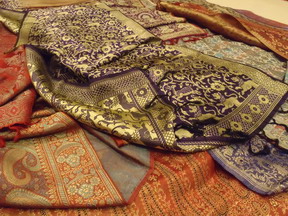
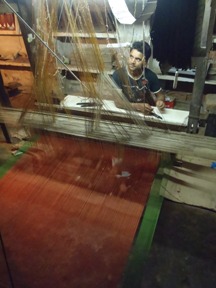
At the end of our tour as often is the case we ended up at a shop. Varanasi is renowned as a centre for silk brocades and beautiful saris and we were taken first to the loom room where we saw the weaving taking place. This was quickly followed by a visit to a shop - we had an interesting look at the saris - though we resented getting the "hard sell" uninvited. They looked nice to me but hard to know what to believe as everyone tries to rip you off in the tourist hot spots. We weren't really in the market to buy anyway.
After the tour it was really hotting up but not having an a/c room to go back to we did the next best thing and found an a/c cyber café where we updated the website. Varanasi was certainly full of life - rickshaws everywhere and lots of little stores like one selling some big fat fish (up to 50kg) from the Ganges -though seeing what goes into it sort of put us off!! Once away from the winding alleys leading up from the Ghats (we're so grateful we didn't try and drive down there!) there were a lot of modern air conditioned shopping malls.
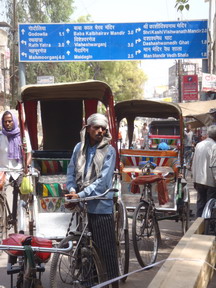
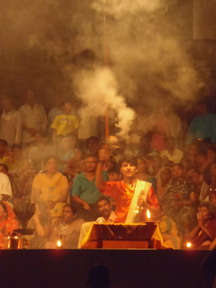
We managed later to see the famous Golden or Vishwanath temple. Well, not really see. We had understood only Hindus could go in but someone approached us and asked if we wanted to go - we said yes and were told to follow the signs to Gate 2. We walked on for ages - eventually got in - to find we could only go into the outer enclosures not inside. What was incredible was the huge police presence - armed with guns they were EVERYWHERE - and we both got a full of search to get as far as we did, I guess as a Hindu icon it's a potential target for extremist attacks. We did get to climb some steps which gave a great view of the golden temple top -850 kgs of gold- pretty impressive but sadly no pictures allowed.
We later took in the evening puja at Dasaswamedh Ghat. We were pretty late as we got a bit disorientated wandering the back streets of the Ghats - but actually timed it right as we arrived as it started so the boat we boarded and watched from was right at the front. The ganga aarti was an elaborate ceremony with puja fire and dance and was pretty impressive. Watching the crowds we felt quite humble that for some people this moment was something incredibly special that they'd cherish forever.
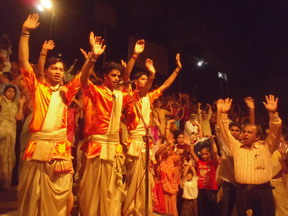
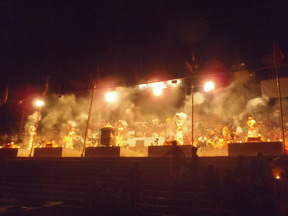
Our last day in Varanasi was not fun. We did a "re-group" of the car. This involves pulling everything out and re-packing and putting any new purchases we don't need away in the storage under the car. This sounds very easy but it isn't - the whole thing took from 5.30am (when we started to beat the heat) until 2.30pm (when the heat had definitely beaten us!) We also took out the fridge and got to the bottom of our fridge issues - we need a new part. We'll have to try and organize getting that sent to Bangladesh however we can - in the meantime we're using the fridge as an ice box the old fashioned way - buying ice blocks from the street vendors you see everywhere.
So after a gruelling day (even the hotel staff were hidden in the shade feeling sorry for us!) we celebrated with a last meal at the Surya. Next morning we headed on but only 10km to the north this time to another place of religious pilgrimage - a Buddhist one - Sarnath.
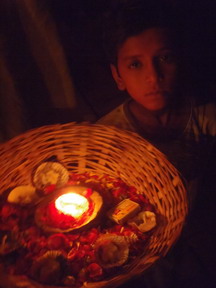

Sarnath is the place where Buddha, having attained enlightenment at Bodhgaya (where we head next) gave his first sermon on the edge of a deer park to a mere handful of followers in the 5th century BC. Ashoka the great Emperor who rejected Hinduism and embraced Buddhism as the state religion built a huge Buddhist colony here 200 years later with stupas and monasteries. Due to Mughal invaders this (and Buddhism in India) later went into decline until the 1830s when it was re-discovered by the British.
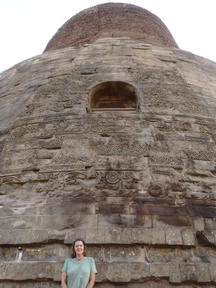

Sarnath isn't far from Varanasi so most people do it as a day trip but it was quite far enough in terms of the crazy traffic so we decided to stay the night there. As a blast from the past we asked to camp at the local Thai Wat. As Sarnath is part of the "Buddhist Circuit" of Lumbini, Kushinagar and Bodhgaya- many Buddhist nations have their monasteries here. The 2 monks at the Thai Wat made us very welcome and we pulled up on the lawn next to the Wat and made friends with the Wat dogs like the old days in Thailand!

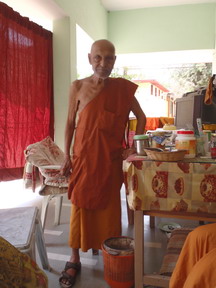
The 2 senior monks at the Wat were both absolutely fascinating. The oldest was a real character. He apologized for his chain smoking saying it was hard to quit as he'd smoked since he left home at 11 years old and he turned 90 next week! Whilst an Indian by birth (like many Buddhists here he'd been born Hindu but converted mainly due to rejection of the caste system which is a real backbone of Hinduism) he'd lived in Thailand for years up to 1965 when he was deported by the Thai government for preaching a sermon the basis of which was that communism and Buddhism were the same. He was also the last living person who was an eye witness to Gandhi's murder in 1948. All in all a fascinating old man. Monk number 2 was equally interesting - mainly as he was pretty anti Gandhi -seeing him as a "political invention" who had done little to promote change. This came from left field a bit and I was a bit taken aback but he was a really intelligent interesting man to speak to. We ended up sitting drinking tea with them till mid morning as they were so fascinating! Good to be "Wat -camping" again!
Sarnath being so close to the tourist hub of Varanasi was very much on the tourist circuit - mainly day trippers - and with tourists you get the touts and the beggars- lots of them! The hassle was pretty full on but thankfully they couldn't get into the enclosure for the main ruins so you could look around in relative peace.
The 34m tall Dhamekh Stupa marks the exact spot in a peaceful park where Buddha preached his famous first sermon. Ashoka's standard - a pillar with 4 lions - also stands nearby. This standard was the inspiration for India's national symbol and the original is housed in the nearby Archaeological Museum - which for the cost of just 5rp (half the cost of using the nearby public loo!) was very much worth a visit.
We had a look round the ruins where local workers were hard at it restoring the ancient monasteries. It was a peaceful place -pretty atmospheric.
Nearby there was a lovely temple dating from 1931 -Mulgandha Kuti Vihar - the interior of which had a beautiful fresco depicting Buddha's life by a renowned Japanese artist. From 6.30pm Buddha's first sermon was chanted which was very atmospheric. Sadly our camera ran out before we could take any pictures inside the temple and as I'd swopped bags we didn't have the spare battery -whoops!

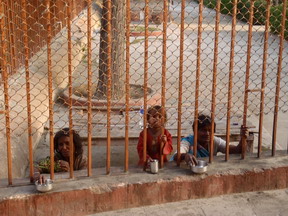
The next day we left Sarnath and drove on to the final point of the "Buddhist circuit "and indeed the most important - Bodhgaya in Bihar where Buddha attained enlightenment. Bihar as detailed before (when we first crossed back into India from Nepal - 6 months ago now) is not the loveliest state, and we were a bit alarmed as we drove to see that a great many of the trucks coming the other way had recently smashed windscreens. We never found out what it was all about - but there were way too many to be accidental. We hurried through with no problems to arrive at Bodhgaya before darkness fell.
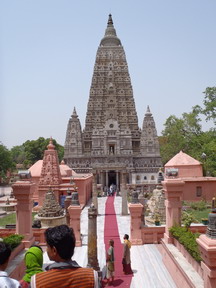
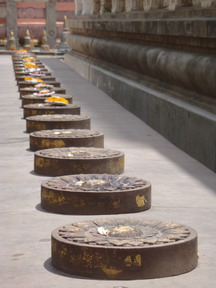
We found a place to camp at the tourist complex - though we had to bargain hard to get a reasonable rate! Next morning we set off (it was already very hot) to see the world heritage listed Mahabodhi temple www.mahabodhi.com This temple was built on the site of a temple initially built by Emperor Ashoka. It has been destroyed and rebuilt a number of times the last major restoration being 1882. The original Bodhi tree - under which Buddha was sitting when he attained enlightenment - was destroyed by Ashoka's wife as she was scared that if he adopted Buddhism entirely he would cast her aside. Ashoka's children (who are credited with spreading Buddhism to Sri Lanka) managed to get a sapling of the tree to Sri Lanka where it was transplanted. The tree which marks the spot where Buddha sat was re-grown from a cutting from this original. It was a lovely serene complex containing one shrine with a Brahmin priest in situ to reflect the cross over from the 2 religions. Hindus worship Buddha (who was originally Hindu) as a reincarnation of the god Vishnu - though Buddhism's complete rejection of the caste system sets it apart from Hinduism. Buddha meditated here for 7 weeks in 7 different types of meditation and each site is marked. The stepping blocks mark the area where he carried out walking meditation - each stone being a stride. Must have had long legs!


We had a very good guide - himself a convert to Buddhism - who took us around the various shrines and was a font of knowledge. His name is Ranjanmi Shra and he can be contacted on 0 9939086249 - if you need his services.
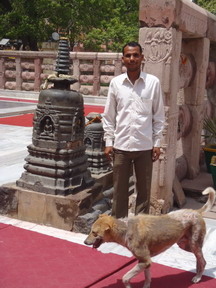
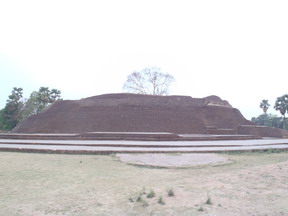
We took a short drive out to a nearby village to see the stupa which marks the home of a local lady Sujatagarh who is part of the Buddha story. She was a rich lady very unhappy to be childless who daily went to pray to the god of the Banyan tree. When she came upon Buddha praying there she thought he was the god and offered him rice and milk. He at first rejected this saying he was seeking enlightenment but she insisted saying he must eat to be strong. He agreed and this was part of the process which lead to him embracing the "middle way" i.e.) not as a wealthy Prince like he started out or as a starving hermit. This is a huge over simplification but that was sort of it! It was beautifully set and nice to see a bit of village life - though we got hassled about visiting schools. Allegedly this is a big scam - you pay for books etc and the kids split the profits with their teachers. No doubt some of them are genuine - just it's hard to know which - so we beat a retreat. It's sad but you can't help everyone.
We saw a few of the representative monasteries from all over the Buddhist world including Japanese, Tibetan, China and even Bangladeshi - the Thai one was particularly fine - some of them were packed full of devotees.
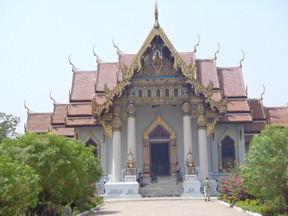
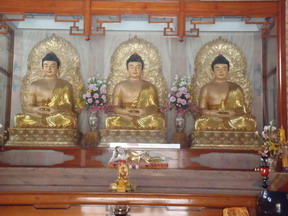
We hid in an internet café through the vicious heat of the day only emerging to go to the temple in the evening to hear the chanting. Sadly we got our wires crossed time wise and missed this - but we still saw all the devotees leaving.
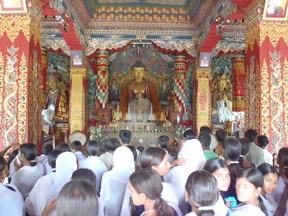

We also saw the giant statue of Buddha - flanked by his 10 disciples - which was opened by his Holiness the Dalai Lama (who comes here every December) in 1989.
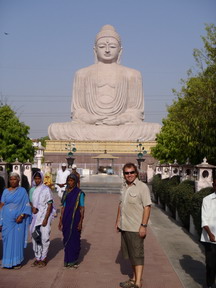
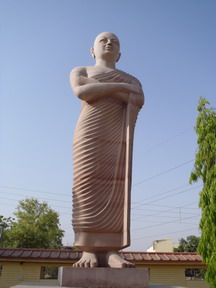
Bodhgaya was a nice tranquil spot and extremely interesting though we had a shock the next day. The papers carried a story of a young Japanese lady who had suffered a vicious gang rape 2 days back after taking a lift from an auto rickshaw to go to the railway station. Apparently there have been others. Sadly this sort of thing does happen everywhere - but I guess travelling as a lady on your own you really do have to be extra vigilant and maybe pay extra to get a taxi.
So on we headed east towards Kolkata (Calcutta) - as we drove east we could feel the humidity rise and the scenery changed as we hit West Bengal very lush with lots of green rice paddies. The rice was ready for harvesting before the wet season hits in the next few weeks. It felt a bit like Kerala - lots of tree lined narrow roads and everywhere men wearing sarongs. Very tropical.
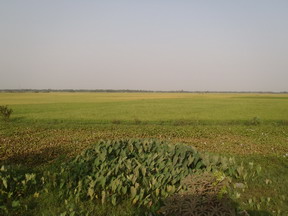

We had admitted defeat re: camping in Kolkata and had booked a room in the Howrah Hotel as recommended by the LP, mainly because it was one of the few budget hotels in the city which had room to park the car. It also looked really easy to find though we got a bit lost when we hit town as the map we had wasn't great and there were loads of one way roads or roads we couldn't drive down. We drove around through some crazy traffic before finally finding the Hotel which stands next to the Howrah Railway and the Howrah Bridge.
As the LP puts it "luxury it aint' but it was an interesting hotel set in a fairly ropey but very characterful area. Dating from 1890 the reception area had an interesting antiquated tile effect and has starred in a few movies -pictures of the Big B on set here hang around the reception. It also had a good courtyard area which (once we'd managed to maneuvere our way in!) felt safe for the car.
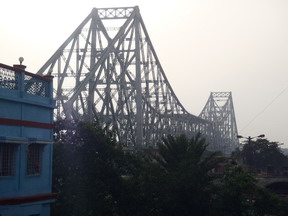

Despite the fact we'd rung to confirm we'd actually been gazumped out of our room. The hotel was full to capacity mainly with nervous young men as the civil service entry exams were taking place the next day and this was the only budget option near the exam hall. So rather than 350 rupees as promised we had to pay 455 rupees. Mind you that wasn't very luxurious so we were quite glad we'd been upgraded! The room was TINY and faced out on to the main road and the bridge - both of which were frenetic.
I think it says a lot for how tired we were that we both slept like the dead all night! The next morning it was interesting seeing the even cheaper boarding houses across the road - they actually sell a space on the roof and sleepers were lined up on the roof tops opposite in rows! I guess this all comes to an end in the monsoon.
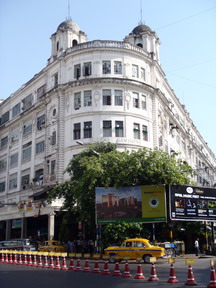
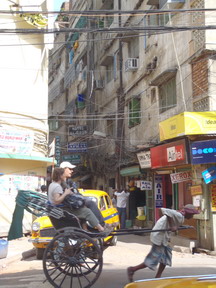
We didn't have time in one day to get more than a feel for Kolkata but the feeling we got was positive. Yes there was poverty and beggars but this is also a very cultured city and was the capital until 1911 so there are some beautiful old colonial buildings everywhere providing a scenic backdrop to the trademark Kolkata yellow taxis.
We headed by foot across the Howrah Bridge which is a 700m long and 60 years old and allegedly remains the busiest bridge in the world. Apparently photography of the bridge isn't allowed - but we didn't know that and so took advantage of the good view from our hotel! On the way across we passed office workers, school kids and loads of porters carrying huge packages on their heads. It was very full on.
We got on the metro and found our way first to Flurys. This is a bit of a Kolkata institution which has been there since the British time and we went in and enjoyed an all day English breakfast. Such a relief to be out of the heat - you just run with sweat - like being back in Darwin!
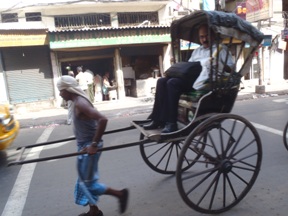
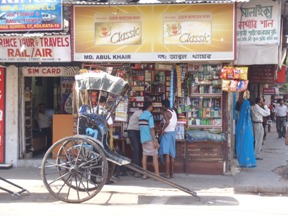
Looking back I'm not sure what we did - we planned to do various things but by the time we'd slept in, got here and eaten there wasn't a lot of time left! One thing of interest we did see was therickshaw pullers. These guys who pull their hand pulled or tana rickshaws are now a dying breed. Seeing this practice as inhumane no new licenses have been given for years and the West Bengal government has toyed with outlawing them. The problem with this is that with no other work these people will be plunged even more into abject poverty - they do it pretty hard as it is. We chatted to a few and they seemed remarkably cheerful considering. During the monsoon they come into their own as these rickshaws are the only way to get through the badly flooded streets and they race through knee deep in water.

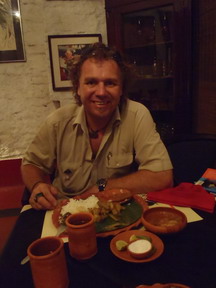
Talking of cheerfulness through adversity -the guy in our picture is a leper and this was obviously his usual patch. We gave him 10 rupees (approx 25 cents Aus) and he was very pleased, and wanted his picture taken. It is really a bit humbling how hard some people have it here.
We managed to see the former home of the lady who tried to help this situation by visiting Mother Theresa's Mission. MT has a somewhat mixed press here. Whilst on one level she is revered as a saint she gets criticism both from Indians -who don't like a non-Hindu who highlights the least attractive aspects of their city to get so much recognition - and from those closer to home who have criticized her for the fact that some of her funds came from dubious sources - like military dictatorships. In addition her Catholic based conversion and no contraception itineraries weren't necessarily in the best interests of the poor. Having said all that it was hard not to be moved by the simplicity of her surroundings. We saw (no pictures allowed) her small camp bed (though often she slept amongst the suffering on the floor) and her battered sandals -about the only possessions she left and you did feel she at least put her money where her mouth was compared with some gurus! Her tomb is in a separate room along with an interesting display of her life. It was remarkably courageous for a lone woman to go into the slums of Calcutta at that time and you really have to respect her for that and for the relief she did bring to the suffering. Very interesting.
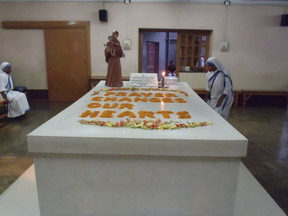
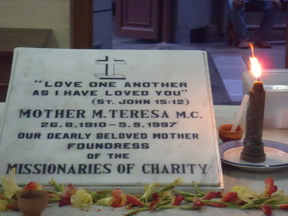
One thing we noticed here is how much less English was commonly spoken. I appreciate this isn't compulsory - we aren't in England after all - just the difference from other big cities was noticeable. We tried to get to the famous Victoria Memorial during the day but never made it so we decided to see the light and sound show that evening. However due to the fact the taxi driver, the security guard and the police couldn't understand us we were dropped in the wrong place so we missed the start by 10 minutes and weren't allowed in. Next time - though by then it may be the wet season so it won't be on anyway.
As a final taste (literally) of Kolkata we went to Kewpies a renowned (but fairly inexpensive) restaurant specializing in Bengali food. We enjoyed fish in mustard oil and vegetables in local sauces -really delicious. The Bengalis are very proud of their cuisine - it has lots of fish and is quite sweet being palm sugar based - and apparently the Bangladeshi food is similar so we'll get to try some there. We both liked this hot steamy friendly city and look forward to returning after Bangladesh - though no doubt it will be pelting down in the monsoons by then. That'll be better than this crazy heat!


So finally the morning of 21 April dawned and we'd used up our 2nd 6 month visa in India and it was time to head on to our next destination of Bangladesh. We got up at 5.30am (not hard in that heat) to beat the worst of the traffic. The area around Howrah was already moving and shaking - truck deliveries, loads of handcarts and general chaos - but most of the shops and businesses weren't yet open so we got out of the city without too much hassle. The 84km to the border was a bit bumpy in parts and very hot and sticky throughout but we arrived safely at the border town of Haridas Pur and after a cursory inspection by customs crossed into our first Bangladesh town of Benapole.
